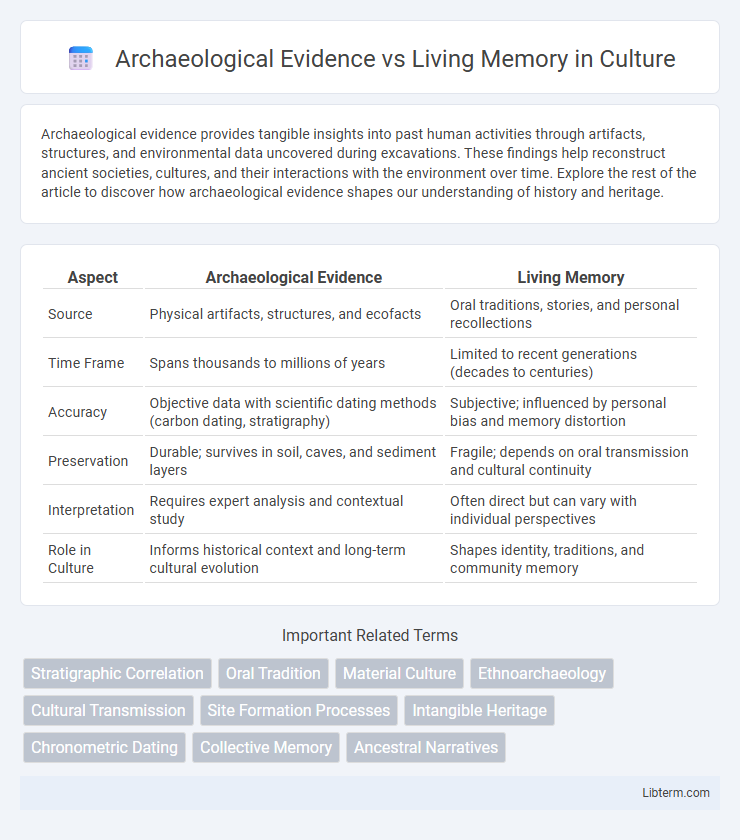Archaeological evidence provides tangible insights into past human activities through artifacts, structures, and environmental data uncovered during excavations. These findings help reconstruct ancient societies, cultures, and their interactions with the environment over time. Explore the rest of the article to discover how archaeological evidence shapes our understanding of history and heritage.
Table of Comparison
| Aspect | Archaeological Evidence | Living Memory |
|---|---|---|
| Source | Physical artifacts, structures, and ecofacts | Oral traditions, stories, and personal recollections |
| Time Frame | Spans thousands to millions of years | Limited to recent generations (decades to centuries) |
| Accuracy | Objective data with scientific dating methods (carbon dating, stratigraphy) | Subjective; influenced by personal bias and memory distortion |
| Preservation | Durable; survives in soil, caves, and sediment layers | Fragile; depends on oral transmission and cultural continuity |
| Interpretation | Requires expert analysis and contextual study | Often direct but can vary with individual perspectives |
| Role in Culture | Informs historical context and long-term cultural evolution | Shapes identity, traditions, and community memory |
Defining Archaeological Evidence and Living Memory
Archaeological evidence consists of physical artifacts, structures, and ecofacts recovered through systematic excavation, providing tangible data about past human activities. Living memory refers to information and traditions passed down orally or through direct experience within communities, often limited to a few generations. The distinction lies in archaeology's material-based approach versus living memory's reliance on human recollection and cultural transmission.
The Role of Material Culture in Historical Understanding
Material culture plays a crucial role in bridging archaeological evidence and living memory by providing tangible artifacts that embody past human experiences and social practices. Objects such as tools, pottery, and architectural remains offer insights into the daily lives, beliefs, and technologies of ancient communities, complementing oral histories and cultural traditions preserved in living memory. This interplay enhances historical understanding by allowing researchers to cross-reference material findings with contemporary recollections, enriching interpretations of human history and cultural continuity.
Oral Traditions: Strengths and Limitations
Oral traditions preserve rich cultural knowledge and community history, offering insights into societies predating written records or archaeological findings. Their strengths include the transmission of values, beliefs, and events across generations, while limitations involve potential alterations over time, memory biases, and challenges in corroborating facts compared to tangible archaeological evidence. Balancing oral traditions with archaeological data enhances historical understanding by combining living memory with physical artifacts to reconstruct past narratives.
Intersecting Timelines: When Memory Meets Artifact
Intersecting timelines reveal crucial insights when living memory converges with archaeological evidence, illustrating how shared human experiences bridge past and present. Artifacts provide tangible connections that validate oral histories and collective memories, enriching cultural identity and historical understanding. The interplay between memory and material culture sharpens interpretations, ensuring a multidimensional approach to reconstructing historical narratives.
Case Studies: Conflicts Between Evidence and Memory
Case studies reveal frequent conflicts between archaeological evidence and living memory, highlighting disparities in historical narratives. For example, the excavation of conflict sites often uncovers material remnants that contradict oral testimonies maintained by local communities, such as the differing accounts of battle locations in the Balkans during the 1990s. These conflicts emphasize the challenges in reconciling tangible artifacts with subjective memories influenced by cultural identity and trauma.
Methodological Challenges in Reconciling Differences
Archaeological evidence and living memory often present contrasting accounts that pose significant methodological challenges, such as discrepancies in temporal scales and interpretative frameworks. Integrating stratigraphic data and radiocarbon dating with oral histories requires critical evaluation of bias, memory decay, and symbolic representations. Researchers must develop interdisciplinary approaches combining ethnographic methods and archaeological science to reconcile these differences and construct coherent historical narratives.
Bias and Reliability in Archaeological and Oral Sources
Archaeological evidence offers material data such as artifacts and stratigraphy that can be scientifically analyzed, yet it is subject to interpretation bias shaped by contemporary theoretical frameworks and excavation methods. Living memory, conveyed through oral traditions, provides culturally embedded narratives that may emphasize subjective experiences and collective identity, influencing reliability through selective memory and transmission errors. Evaluating historical events requires cross-referencing these sources to mitigate bias inherent in both physical evidence and oral histories, enhancing a comprehensive understanding of the past.
Cultural Significance of Living Memory
Living memory preserves cultural significance by transmitting traditions, values, and rituals directly through generations, enriching community identity and continuity. Unlike archaeological evidence, which offers static, material insights, living memory embodies dynamic, experiential knowledge that shapes collective understanding and social cohesion. This ongoing oral transmission ensures that cultural heritage remains relevant and adaptable to contemporary contexts.
Technological Advances in Archaeological Verification
Technological advances in archaeological verification, such as ground-penetrating radar, 3D scanning, and advanced DNA analysis, have significantly enhanced the ability to validate and interpret physical evidence beyond living memory. These tools enable archaeologists to uncover hidden structures, precisely date artifacts, and reconstruct ancient environments with unprecedented accuracy. Integration of these technologies bridges the gap between archaeological evidence and oral histories, offering a more comprehensive understanding of past human activities.
Bridging the Gap: Integrative Approaches to the Past
Integrative approaches to the past combine archaeological evidence with living memory to create a more holistic understanding of history. This methodology leverages oral histories and material culture, enriching data interpretation and contextualizing findings within community narratives. Such collaboration bridges the gap between scientific analysis and cultural identity, enhancing the relevance and accessibility of archaeological research.
Archaeological Evidence Infographic

 libterm.com
libterm.com